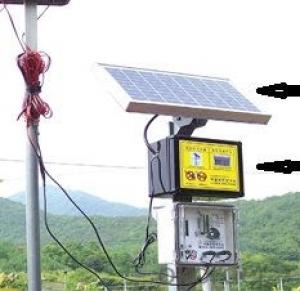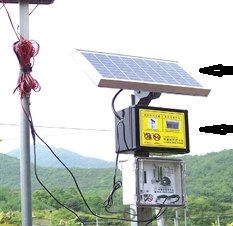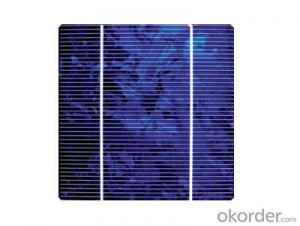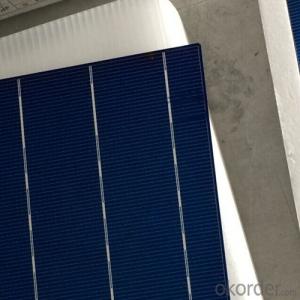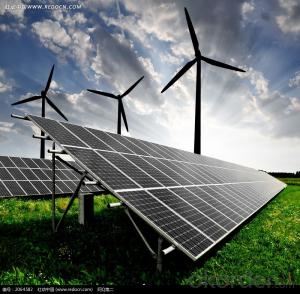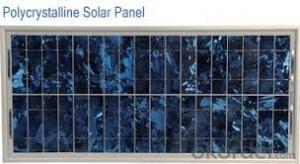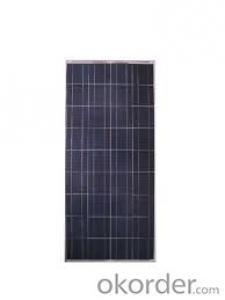Price Solar Cells - Manufacture in China Poly Solar Panel with 25 Years Warranty CNBM
- Loading Port:
- Qingdao
- Payment Terms:
- TT OR LC
- Min Order Qty:
- 10 set
- Supply Capability:
- 300000 set/month
OKorder Service Pledge
OKorder Financial Service
You Might Also Like
Polycrystalline Solar Modules
CNBM offers a range of small, medium and large polycrystalline solar modules, designed for a range of requirements.
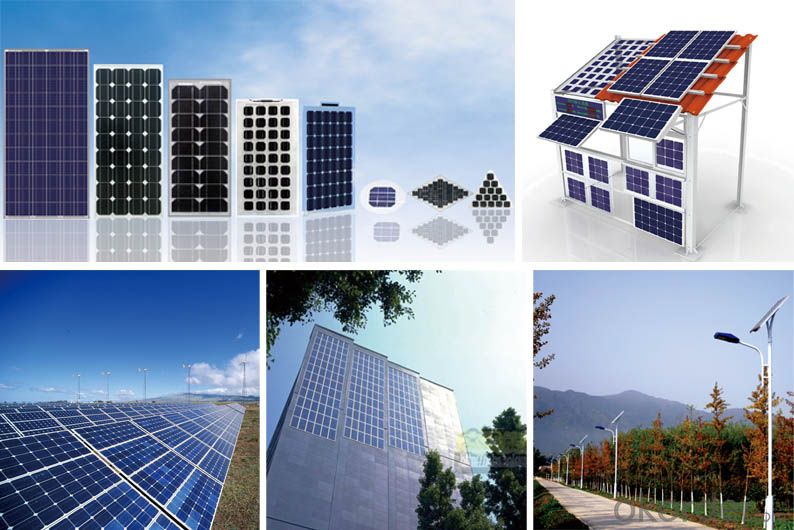
Specifications:
Tolerance | +/-3% |
Cell | Polycrystalline silicon solar cells (156 x 156mm) |
N0. of Cells | 60 (10 x 6) |
Dimension of Modules (mm) | 1650 x 990 x 40 |
Weight (kg) | 25.5 |
Limits:
Operating Temperature | -40~+85? |
Storage Temperature | -40~+85? |
Maximum System Voltage | 1000 VDC max. |
Hail Impact | Diameter of 28mm with impact speed |
Temperature and Coefficients:
NOCT | 48C+/-2? |
Voltage temperature coefficient (%/K) | -0.35 |
Current temperature coefficient (%/K) | 0.05 |
Power temperature coefficient (%/K) | -0.45 |
Characteristics:
Model: | SGM-200P | SGM-210P | SGM-220P |
Max-power voltage Vmp (V) | 29.2 | 29.4 | 29.41 |
Max-power current Imp (A) | 6.85 | 7.14 | 7.48 |
Open-circuit voltage Voc (V) | 36.5 | 36.69 | 36.9 |
Short-Circuit Current Isc (A) | 7.28 | 7.6 | 7.93 |
Max-power Pm(W) | 200 | 210 | 220 |
Model: | SGM-230P |
Max-power voltage Vmp (V) | 29.8 |
Max-power current Imp (A) | 7.72 |
Open-circuit voltage Voc (V) | 37.31 |
Short-Circuit Current Isc (A) | 8.19 |
Max-power Pm(W) | 230 |
STC: Irradiance 1000W/m2, module temperature 25?, AM-=1.5
Poly Crystalline Solar Panels Specifications Range
Maximum Power (Pm) | Dimension | Weight | Operating Voltage (Vmp) | Operating Current (Imp) | Open Circuit Voltage (Voc) | Short Circuit Current (Isc) |
0.45W | 140x80x10mm | 0.08kg | 3.3V | 150mA | 4.6V | 160mA |
1.0W | 162x140x10mm | 0.16kg | 7.5V | 150mA | 10.3V | 160mA |
4.5W | 269x251x23mm | 0.8kg | 16.5V | 0.27A | 20.5V | 0.3A |
10W | 420.1×268.9×22.6mm | 1.92kg | 17.5V | 0.58A | 20.5V | 0.6A |
20W | 425x502x50mm | 3.0kg | 16.8V | 1.19A | 21.0V | 1.29A |
30W | 593x502x22.6mm | 3.9kg | 16.8V | 1.78A | 21.0V | 1.94A |
40W | 655x537x50mm | 5.75kg | 17.3V | 2.31A | 22.1V | 2.54A |
50W | 839x537x50mm | 6.0kg | 17.5V | 2.9A | 21.8V | 3.17A |
65W | 1111x502x50mm | 7.2kg | 17.6V | 3.69A | 22.1V | 3.99A |
80W | 1204x537x50mm | 7.7kg | 17.6V | 4.55A | 22.1V | 4.8A |
- Q: How do solar cells perform in areas with frequent earthquakes?
- Solar cells are designed to withstand earthquakes to some extent, but the performance can be affected depending on the severity of the earthquake. If the solar cells are properly installed and secured, they can generally withstand moderate earthquakes without significant damage. However, in areas with frequent and strong earthquakes, additional measures like reinforced mounting systems may be necessary to ensure the long-term performance and durability of the solar cells.
- Q: How do solar cells perform in high-pollution areas?
- Solar cells can still function effectively in high-pollution areas, although their performance may be slightly reduced due to the presence of air pollutants. The efficiency of solar cells depends on the amount of sunlight they receive, so in areas with high pollution, the concentration of pollutants in the air may partially block sunlight and reduce the amount of energy captured by the cells. However, advancements in solar technology have led to the development of more resilient and efficient solar panels that can still generate a significant amount of energy, even in high-pollution areas.
- Q: How are solar cells affected by temperature?
- Solar cells are negatively affected by high temperatures, as they can cause a decrease in efficiency and overall performance. The increase in temperature can lead to an increase in resistance, which reduces the flow of electric current within the cell. This decrease in current output results in a decrease in power generation. Additionally, high temperatures can accelerate the degradation of the materials used in solar cells, reducing their lifespan. However, low temperatures can have a positive effect on solar cell performance, as they can increase the efficiency and power output.
- Q: Can solar cells be used in water?
- Yes, solar cells can be used in water. However, it is important to note that the efficiency of solar cells decreases when submerged in water due to reduced sunlight penetration. Additionally, precautions must be taken to ensure the waterproofing and insulation of the solar cells to prevent any damage or electrical hazards.
- Q: What is the impact of solar cell installations on job creation?
- Solar cell installations have a significant positive impact on job creation. By promoting the growth of the renewable energy sector, these installations create a wide range of job opportunities across various fields such as manufacturing, installation, maintenance, and research. The demand for skilled workers in solar-related industries has been steadily increasing, leading to job creation and economic growth. Additionally, the solar industry often provides employment opportunities at both the local and national levels, contributing to the overall development of the workforce and the economy.
- Q: How do solar cells handle temperature fluctuations?
- Solar cells are designed to handle temperature fluctuations by incorporating materials that can withstand high temperatures. They are also equipped with cooling mechanisms to dissipate excess heat and maintain optimal operating temperatures. Additionally, solar cells are designed to minimize the impact of temperature changes on their performance by employing temperature coefficients that adjust the electrical output accordingly.
- Q: Anybody ever heard of thin film solar cell? What it that?
- I did hear that term once, but can't remember what it is.
- Q: What is the impact of partial shading on solar cell performance?
- Partial shading on solar cell performance can have a significant negative impact. When a solar cell is partially shaded, even a small portion of shading can reduce its overall power output. This is because shaded cells create voltage mismatches within the solar panel, leading to decreased current flow and overall efficiency. Additionally, partial shading can also cause hotspots, which can damage the solar cells and reduce their lifespan. Therefore, it is crucial to design solar systems carefully, avoiding any shading to ensure optimal performance and maximize energy generation.
- Q: How do solar cells affect the aesthetics of a building?
- Solar cells can have a significant impact on the aesthetics of a building. While their installation may alter the appearance of the structure, advancements in solar technology have led to more aesthetically pleasing designs. With options like integrated solar panels or solar shingles that blend seamlessly into the building's design, solar cells can enhance the overall aesthetics and even contribute to a more modern and sustainable look. Additionally, the sight of solar panels on a building can signal an environmentally conscious approach, which many people find visually appealing.
- Q: Can solar cells be used for powering hotels?
- Yes, solar cells can be used for powering hotels. Solar cells, also known as photovoltaic cells, convert sunlight into electricity, providing a sustainable and renewable energy source. By installing solar panels on the roofs or in open spaces around hotels, they can generate clean energy to meet a portion or even the entire electricity demand of the establishment, reducing reliance on traditional power sources and resulting in cost savings.
Send your message to us
Price Solar Cells - Manufacture in China Poly Solar Panel with 25 Years Warranty CNBM
- Loading Port:
- Qingdao
- Payment Terms:
- TT OR LC
- Min Order Qty:
- 10 set
- Supply Capability:
- 300000 set/month
OKorder Service Pledge
OKorder Financial Service
Similar products
Hot products
Hot Searches
Related keywords
